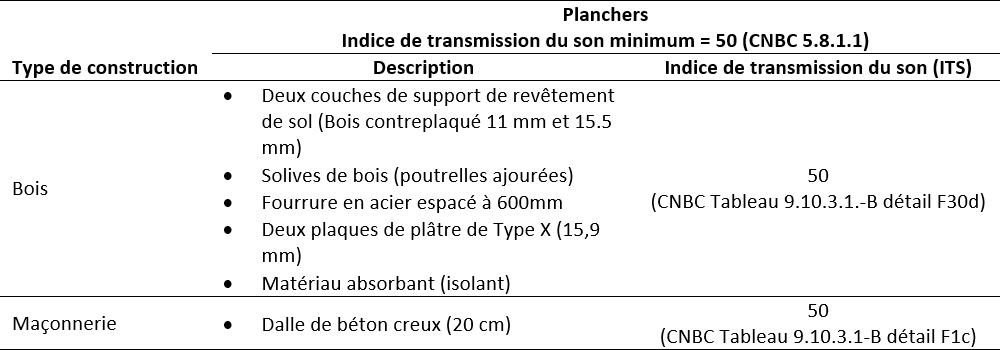What other benefits come along with masonry construction?
Soundproofing and Other Benefits
The high sound transmission class of masonry walls, in addition to the effects of its thermal mass that limits ambient temperature fluctuations and the durability of the material, allow the structure a long useful life and contributes to the comfort of the occupants.
According to the National Building Code (NBCC), housing units must be isolated from each other by separations (walls and floors) with a sound transmission class (STC) for airborne noise of at least 50. This means that loud noises (e.g., from musical instruments or speakers) can hardly be heard. The details of common lumber floors and walls presented in Tables 1 and 2 achieve the necessary STC with a complex system requiring multiple layers of plasterboard and absorbent (insulation) materials. In addition, as is the case with fire resistance, it will be important to ensure the long-term maintenance of the soundproofing system, as its performance may deteriorate over time with wear. For loadbearing masonry construction, walls and floors reach the minimum STC rating on their own. These materials are durable, and their performance is therefore not likely to decrease over time. In addition, the inclusion of finishing materials (such as plasterboard added to the walls), can further increase the STC rating. Measures to reduce the transmission of low-frequency and impact noise can also be integrated, depending on the specific needs of the project.
Table 1: Composition and soundproofing index of floors

a Materials required to give the wall adequate fire resistance (1h) give it an STC rating higher than the minimum required in the code
b If the concrete block wall is filled with grout, which is often required in lower levels of multi-storey buildings for structural reasons, the ITS value increases to 56 (Sound Properties and Details, CCMPA)
Table 2: Composition and soundproofing index of walls

Tableau 1: Composition et indice d’insonorisation de planchers

a Les matériaux nécessaires pour donner au mur une résistance aux incendies adéquate (1h) lui donnent une valeur ITS supérieure au minimum requis dans le code
b Si le mur de blocs de béton est rempli de coulis, ce qui est souvent requis dans les niveaux inférieurs d’immeubles à multiples étages pour des raisons structurales, la valeur ITS augmente à 56 (Sound Properties and Details, CCMPA)
Tableau 2: Composition et indice d’insonorisation de murs

Masonry materials also have desirable thermal properties. Their high thermal mass helps stabilize a building’s interior temperature, which can help reduce heating and cooling costs. In addition, the durability of the building material ensures that the desirable properties of the structural elements (fire resistance, soundproofing, thermal mass) will be perpetuated over a long period of time. Masonry is weather resistant, does not rot and is not susceptible to water damage. It is also resistant to vandalism and accidental shocks that could severely damage the structural or finishing elements of a wooden structure. Concrete block masonry is therefore an ideal system for the construction of mid-rise residential building structures.
Skeptical? Check our math
Full Study including design drawings, scheduling, budget, and even structural drawings is available as part of the full cost study
Get in touch with our team
The Canada Masonry Design Centre helps members of the design community across the country by connecting them to the resources and supports they need. Contact us today and get the conversation started!
Contact Us

